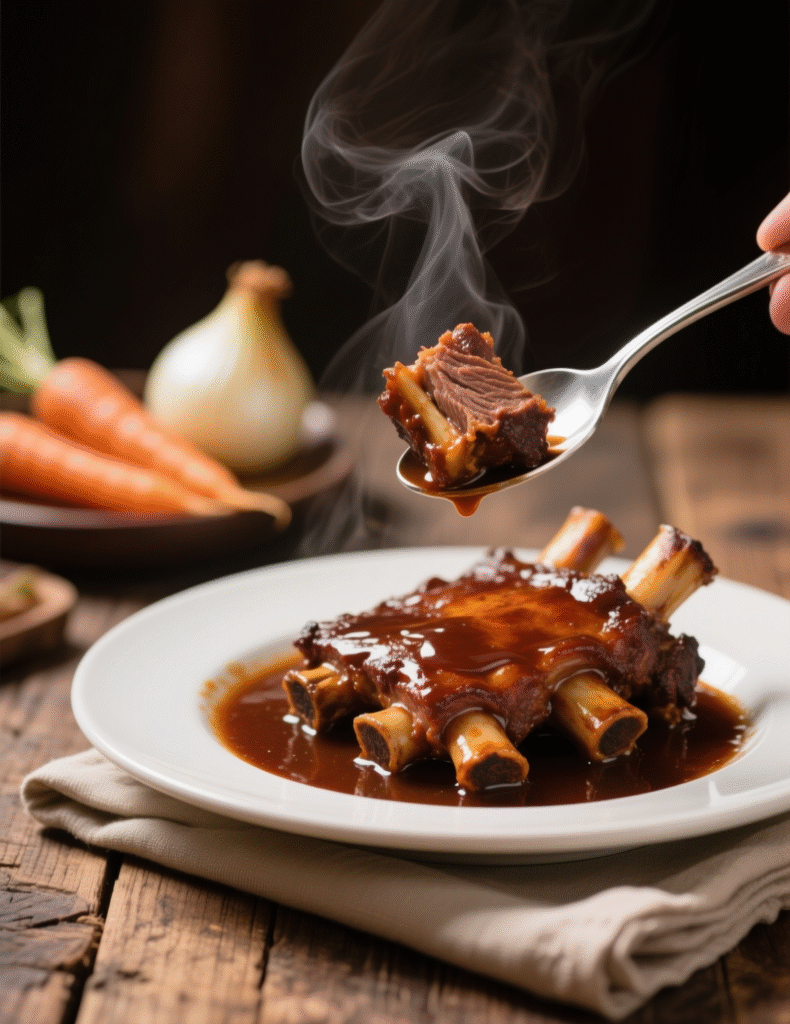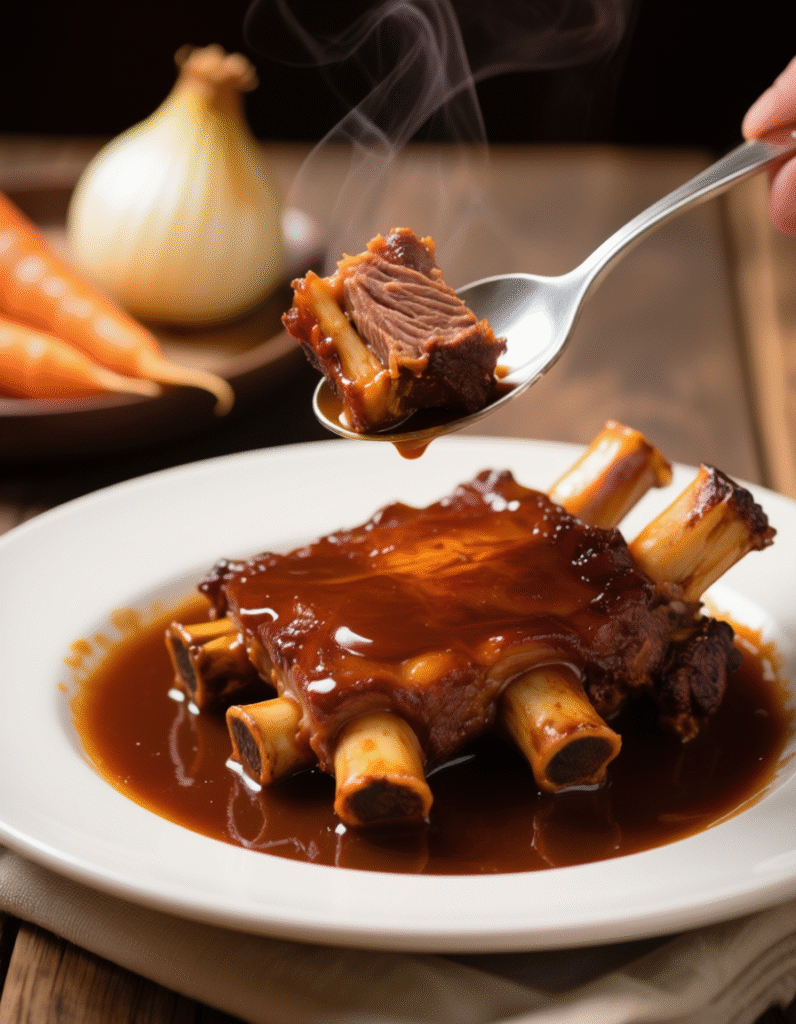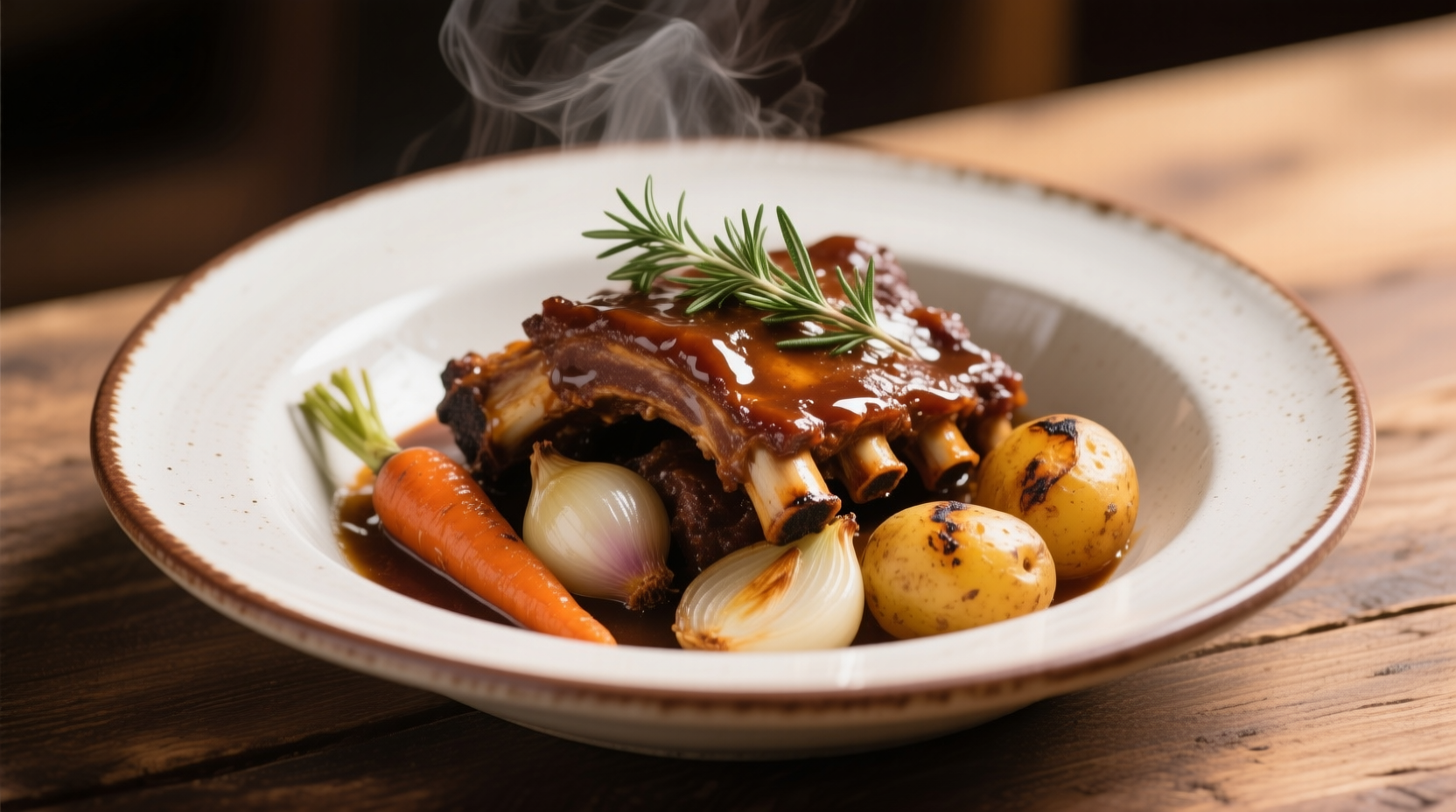There’s something magical about a pot of braised short ribs bubbling away, the smell curling through the kitchen. Ask ten chefs how to braise and you’ll get ten answers, all with their quirks. This dish isn’t just food—it’s technique, patience, and that slow alchemy where tough meat becomes velvet.
Why Short Ribs Work So Well
Beef short ribs carry more connective tissue than most cuts. That’s exactly why they’re gold for braising. Collagen melts slowly, turning what begins as tough and sinewy into silky and rich. In fact, collagen converts to gelatin around 160–180°F (71–82°C), which is the sweet zone for braises. A rib-eye might scream on a grill, but short ribs whisper, “take your time.”
Another factor is fat. Not just marbling, but the actual fat cap. It bastes the meat and creates depth in the braising liquid. You can trim it, but not too much—chefs who hack away often regret losing flavor.
The Backbone of Braising
Braising is old, older than you think. Cultures across Europe, Asia, and Africa have been simmering tough meats in liquid for centuries. It’s part science, part instinct. Heat, time, and moisture break down proteins and fats in a way roasting never can.
The trick is balance. Too much liquid and you end up with boiled beef. Too little and the pot scorches. The rule of thumb is to cover the meat about two-thirds of the way. That keeps the tops caramelized and the bottoms tender, creating contrast.
Choosing the Ribs
Not all short ribs are equal. Plate short ribs are longer, meatier, often used in Korean galbi. English-cut short ribs are chunky and ideal for slow braising. Flanken style, cut across the bone, gives more bone-to-meat ratio and is favored in Jewish and Korean kitchens.
If you want a professional tip—look for ribs with visible marbling but not too much hard fat. Bone-in is always preferred, since bones enrich the sauce with marrow. Chefs in fine dining know this well: the sauce matters as much as the meat.
Building Flavor: The Sear
Never skip searing. That crust isn’t just for looks. It’s the Maillard reaction—amino acids and sugars combining under heat to form hundreds of new flavor compounds. Sear in small batches, don’t crowd the pan. The meat should hiss, not steam.
Use a heavy-bottomed pot, ideally cast iron or enameled Dutch oven. Stainless can work but tends to create hot spots. The color you build on the meat is the backbone of the sauce, so don’t rush it.
The Mirepoix Base
Every cuisine has its holy trinity. French mirepoix: onion, carrot, celery. Italian soffritto: onion, carrot, garlic. Cajun: onion, celery, bell pepper. For short ribs, the French approach wins most often. Dice the vegetables evenly so they cook at the same pace.
Sweat them in the same pan after searing, scraping up fond as you go. This builds a sweet-savory depth. You don’t need huge chunks; small dice melts into the sauce, which is what you want. Nobody enjoys fishing soggy carrot sticks out of their braise.

Deglazing: Where Magic Begins
Wine is the classic deglazer. Red wine brings tannins and acidity that cut through richness. Burgundy or a Rhône blend is traditional, but don’t stress—any full-bodied red works. White wine, though less common, gives brightness and works if you want a lighter sauce.
When you pour the wine into that sizzling pot, something happens—fond lifts, aromas bloom, steam rises. Reduce the wine by half, always. Raw alcohol flavors ruin a braise. Reduction concentrates flavor and ensures the final sauce isn’t thin or harsh.
Liquid Choices Beyond Wine
Stock is non-negotiable. Beef stock deepens the flavor, chicken stock softens it, veal stock makes it luxurious. Some chefs even use mushroom stock for earthiness. Avoid store-bought broths that are salty or flat—homemade is best, though high-quality frozen broths can work.
A splash of balsamic vinegar or sherry vinegar at the start adds brightness. Tomato paste too, when caramelized, layers in umami. Think of braising liquid like a symphony—you don’t want one instrument blasting, you want harmony.
Low and Slow: Temperature Control
Short ribs want gentle heat. Around 300°F (150°C) in the oven is the gold standard. Any higher and the liquid boils, toughening fibers. Any lower and the process drags, sometimes leaving meat chewy.
The cooking time is usually 2.5 to 3.5 hours, depending on size and thickness. You’ll know they’re done when a fork slides in without resistance. If you need a number: internal temp around 200°F (93°C) signals gelatin is fully melted.
Skimming and Clarity
During braising, fat rises to the top. Professionals skim religiously. Not all of it, though—fat is flavor. But leaving too much leaves a greasy mouthfeel. The trick is to skim as you go, not just at the end.
Some chefs chill the entire pot overnight, letting fat solidify on top for easy removal. This also deepens flavor since the meat rests in the liquid. Many Michelin kitchens swear by the “day-after braise” rule—it tastes better, period.
Garnishes and Finishing Touches
Fresh herbs right at the end make a huge difference. Thyme, parsley, even a touch of tarragon can lift richness. Zest of orange or lemon brightens the sauce more than people expect.
For the sauce, strain the liquid, reduce to nappe consistency, and mount with cold butter. That’s chef speak for whisking butter in off the heat, giving it sheen and silk. Don’t just dump the ribs back in a watery sauce. Elevate it.
Plating Like a Pro
Short ribs can be rustic or refined. For rustic, serve them bone-in over mashed potatoes or polenta. For refined, debone, slice against the grain, and glaze with the reduced sauce. Place atop a parsnip purée, drizzle with jus, and finish with microgreens.
The bones themselves, cleaned, can be used as garnish. Some modernist chefs even stuff them with bone marrow purée. The presentation depends on the audience, but the core is always the same: melt-in-your-mouth beef with a sauce that clings.

Common Mistakes Cooks Make
Boiling instead of braising—huge mistake. It toughens the meat.
Using cheap, sour wine—your sauce will taste like it.
Skipping the sear—you’ll get pale meat and bland sauce.
Rushing the cook time—short ribs don’t forgive impatience.
Adding too much liquid—you’ll dilute flavor, not intensify it.
Braised Short Ribs Recipe (Professional Method)
Ingredients
- 4 lbs bone-in short ribs
- 2 tbsp neutral oil
- 2 onions, diced
- 2 carrots, diced
- 2 celery stalks, diced
- 3 tbsp tomato paste
- 2 cups dry red wine
- 3 cups beef stock
- 4 cloves garlic, smashed
- 2 sprigs thyme
- 2 sprigs rosemary
- 2 bay leaves
- Salt and pepper to taste
Method
- Preheat oven to 300°F (150°C).
- Season ribs generously with salt and pepper.
- Heat oil in Dutch oven, sear ribs on all sides until deep brown. Remove.
- Add mirepoix, cook until softened. Add tomato paste, cook until darkened.
- Deglaze with wine, reduce by half.
- Add stock, garlic, herbs. Return ribs. Liquid should come 2/3 up the meat.
- Cover and braise in oven 3 hours, until fork-tender.
- Remove ribs, strain sauce, skim fat, reduce if needed.
- Serve ribs glazed with sauce.
Modern Twists and Trends
Today’s chefs experiment with global spins. Korean-style braised short ribs use soy, sesame oil, pear juice. Mexican versions add ancho chiles, cinnamon, and beer. Some chefs even finish braises with miso for a punch of umami.
Sous-vide braised ribs are also trending—cooked at 167°F (75°C) for 24 hours, then seared and sauced. The texture is more consistent, though purists argue it lacks the depth of traditional braising.
Nutritional Insights
Short ribs aren’t lean. A 4-ounce portion carries about 400 calories, mostly from fat. Yet, much of the fat renders out in cooking. Serving sizes can be managed with sides heavy in vegetables and lighter starches. Braised short ribs are indulgence food, yes, but with balance they fit into modern dining.
Final Thoughts
Braised short ribs aren’t about flash, they’re about patience. They reward cooks who respect time and process. From choosing the right cut to mastering the sauce, every step matters.
Chefs know the secret: let the meat and liquid do the work. You just guide them, adjusting heat, tasting often, and waiting. Do it right, and you’ll serve a dish that stops conversation at the table—the kind where people just nod and smile as they eat.
FAQs
How long should braised short ribs cook?
Usually 2.5 to 3.5 hours in a 300°F oven until fork-tender.
Can I make braised short ribs ahead of time?
Yes, they taste even better the next day after resting in the sauce.
What wine works best for braised short ribs?
A full-bodied red like Cabernet Sauvignon, Syrah, or a Rhône blend works perfectly.
Can I freeze braised short ribs?
Yes, they freeze well for up to 3 months in airtight containers.
Do I need bone-in short ribs?
Bone-in is best for flavor, though boneless can still work if that’s all you find.
How do I reheat braised short ribs?
Gently reheat in their sauce on the stovetop or in the oven at low heat.
What sides pair well with braised short ribs?
Mashed potatoes, creamy polenta, roasted root vegetables, or buttered noodles are classics.
Can I use a slow cooker instead of the oven?
Yes, 8–9 hours on low in a slow cooker gives tender results.
How do I thicken the braising sauce?
Reduce it on the stovetop until it coats the back of a spoon.
Can I braise short ribs without wine?
Yes, substitute with extra stock plus a splash of balsamic or vinegar for acidity.

Mariana is a passionate home cook who creates delicious, easy-to-follow recipes for busy people. From energizing breakfasts to satisfying dinners and indulgent desserts, her dishes are designed to fuel both your body and hustle.
When she’s not in the kitchen, she’s exploring new flavors and dreaming up her next recipe to share with the Foodie Hustle community.

